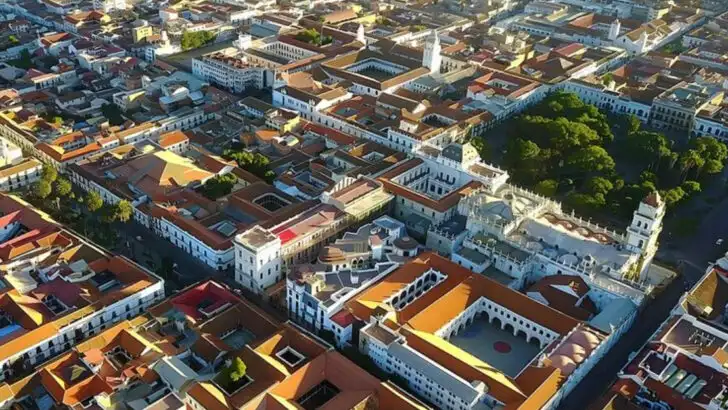Think South America begins and ends with Buenos Aires and Rio? Travelers in the know are charting quieter paths—places where color-splashed hillsides, colonial lanes, and surreal natural wonders reward those who wander farther. From condor country to mirror-flat salt deserts, these destinations trade crowds for character and depth. Read on for thirteen gems that deliver atmosphere, adventure, and stories you’ll still be telling next year.
Valparaíso, Chile — the city of painted hills and old ascensores
Narrow streets climb like staircases between balconies and murals, while rusted ascensores chug up painted hills toward windy overlooks above the port. Ride a funicular at dusk and listen for gulls and distant ship horns echoing between corrugated facades. Cafés spill onto alleys, and stair art turns every corner into a gallery. Distinctive detail: the tiered collage of color and the creaking hillside elevators make Valparaíso feel assembled in layers, each landing a new view.
Mendoza, Argentina — wine country under the Andes
Vineyards sprawl across sun-washed plains beneath snow-laced Andes, where tastings meander from crisp torrontés to plush malbec. Olive mills and simple grills pair charred meats with rich reds, while bike paths thread quiet country roads. Afternoons stretch long and honeyed; evenings are unhurried, built around conversation and clinking glasses. Distinctive detail: the region’s slow, social rhythm and mountain horizon make even modest bodegas feel cinematic.
Salta, Argentina — colonial charm and highland roads
Salta’s palm-shaded plaza, tiled roofs, and bell towers set a relaxed stage for forays into red-rock quebradas and cactus-studded highlands. Museums map Indigenous routes and Andean rituals, while mercados fry empanadas salteñas to flaky perfection. Day trips roll past adobe villages and switchbacks to painterly viewpoints. Distinctive detail: the northwest’s flavors—ají spice, local wines, and hearty stews—color the city’s colonial calm with mountain warmth.
Cartagena, Colombia — Caribbean-colonial streets and sea breeze
Within thick fortifications, Cartagena’s lanes open into intimate plazas perfumed by jasmine and frying arepas de huevo. Balcony shadows stripe cobbles as street musicians tune up and sea breezes thread the walls. Evenings ease into golden-hour walks along ramparts with views of the bay’s glittering boats. Distinctive detail: UNESCO-listed defenses and painted colonial houses frame daily life in a tropical theater of color and sound.
Medellín, Colombia — a city of neighborhoods and spring-like weather
Medellín’s endlessly springlike climate spills life into plazas, outdoor markets, and hillside cafés. Cable cars soar to barrios where murals bloom, linking viewpoints, neighborhood bakeries, and pocket parks with the efficient metro. Innovation hubs and botanical gardens sit beside soccer courts and flower vendors. Distinctive detail: the metro-cable network makes exploring hilltop corners feel easy, revealing a city stitched together by public space.
Cuenca, Ecuador — rivered streets and colonial calm
Cuenca flows at a human pace, where stone bridges cross a mild river and whitewashed churches anchor leafy squares. Craftspeople shape toquilla straw into elegant hats, and museums trace layers of Andean and colonial history. Cafés spill onto cobbles, inviting slow meanders between galleries and riverside paths. Distinctive detail: a lived-in historic core—quiet, tidy, and architectural—makes lingering feel natural.
Galápagos Islands, Ecuador — wildlife encounters off the continent
Boat hops and guided walks bring you face-to-face with creatures that barely notice humans—blue-footed boobies, lounging sea lions, and slow-moving tortoises. Snorkels reveal sea turtles and dancing rays above lava reefs. Trails are carefully managed, with rules protecting fragile habitats and unbothered wildlife. Distinctive detail: this UNESCO reserve is a living laboratory where proximity to endemic species feels wondrous yet respectfully controlled.
Arequipa & Colca Canyon, Peru — white-stone city and condor country
Arequipa glows in volcanic sillar, its plazas framed by arcades and distant cone-shaped peaks. A few hours away, Colca’s terraces stagger into a deep valley where dawn thermals lift condors into graceful circles. Towns along the route serve hearty soups and river trout as steam curls from thermal baths. Distinctive detail: mornings tuned to condor flights make the canyon feel theatrically alive.
Huaraz & the Cordillera Blanca, Peru — glacier lakes and trekking routes
From compact Huaraz, trails launch into a granite world of turquoise lakes beneath serrated, snowy walls. Day hikes reach mirror-still lagoons; multi-day circuits link high passes, condors, and star-frosted camps. Glaciers gleam above grazing llamas, and mountain huts offer hot soup after long ascents. Distinctive detail: the vivid contrast of blue lakes and dark rock makes every climb feel expedition-worthy.
Salar de Uyuni, Bolivia — the high-altitude salt plain
A vast, white expanse stretches so flat it warps perspective; after rains, a shallow sheen transforms the salar into a perfect mirror. 4x4s skim toward cactus isles and horizons that refuse to arrive. Sunsets explode twice—once above, once below—while stars feel close enough to touch. Distinctive detail: the world’s largest salt flat is so uniform it’s used for satellite calibration.
Sucre, Bolivia — a small, whitewashed city with slow rhythm
Sucre’s white facades and cool highland air invite slow wandering between courtyards and convents. Markets brim with fresh cheeses, breads, and herbal teas, while museums outline Bolivia’s constitutional past. Evenings drift softly through plazas where families gather beneath orange lamps. Distinctive detail: compact, calm streets make history feel approachable—and rest easy between Andean journeys.
Colonia del Sacramento, Uruguay — cobbles, lighthouse, and ferry connections
Just a ferry from Buenos Aires, Colonia’s cobbled lanes and low lighthouse set a river-town rhythm. Vintage cars rest beside ivy-wrapped façades as the sun melts into the Plata. The UNESCO-listed quarter blends Portuguese curves with Spanish grids in a walkably compact maze. Distinctive detail: a preserved, layered streetscape turns simple strolls into time travel.
Lençóis Maranhenses National Park, Brazil — seasonal lagoons between sand dunes
After the rains, rainwater gathers between wind-sculpted dunes, forming brilliant blue-green lagoons you can wade and swim between. Paths ripple along bright sand ridges, revealing curving pools that shift with each season. Guides time visits to the cleanest, fullest lagoons and sunset’s soft pastels. Distinctive detail: a changing, ephemeral water-and-sand mosaic unlike any other landscape in Brazil.

